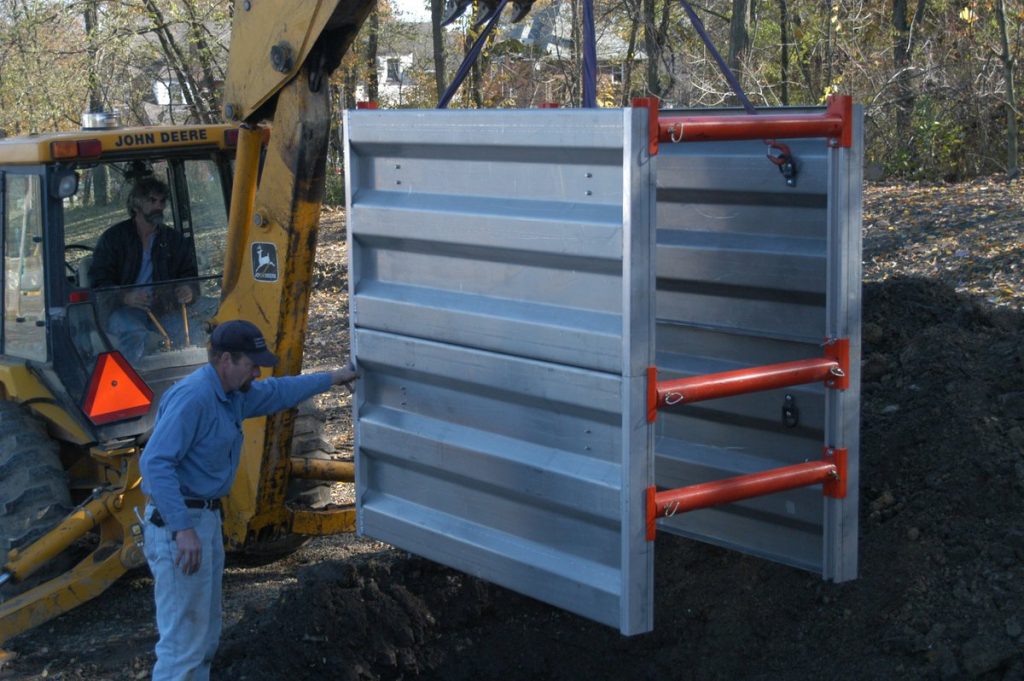Trench box is a system that shores up an excavation to avoid soil cave-ins and protect workers. It involves installing aluminum hydraulic supports.
Shoring supports prevent the surrounding soil, rock, and adjacent structures from collapsing due to trenching works. Regulatory requirements dictate that any trench more than 1.30m deep involving any risk of collapse or burial should be shored or braced.
Sizes
Trench boxes come in a variety of sizes. They are designed to protect workers from being buried in the event of a trench collapse or cave-in. Some are designed for use by employees who are working on site excavations such as laying pipes or cabling, while others are used in smaller digs for manhole repairs and other underground construction projects.
Safety equipment for trenching or excavation is a necessity for most construction sites. In addition to trench box workers may also need to use protective systems such as shoring or shielding. Shoring prevents cave-ins by applying positive pressure against the trench walls. Shielding, on the other hand, is a passive system that provides protection from collapsing walls, but does not prevent them from happening.
Workers need to know how to identify the best type of protective system to use, according to a recent press release from United Rentals. They should familiarize themselves with the types of soils that can be encountered on jobsite excavations and how they influence the trench protective system solutions that can be employed – sloping, benching, shielding or shoring. It is also important to remember that soil conditions should be reevaluated whenever there are changes on the jobsite.
There are a number of different types of trench boxes available, including aluminum and steel options. Lightweight aluminum systems can be easily moved by backhoes and other rubber-tired vehicles. These systems are ideal for small utility or cable projects, municipal maintenance and on-the-spot troubleshooting applications. They include spreader bars that can be adjusted to various heights for optimal support and safety. They are also easy to transport and require less storage space than heavier steel models.
Another option is the UltraShore trench box, which is made of a corrugated metal that offers protection in trenches up to 12 feet deep. This lightweight, portable shoring product weighs hundreds of pounds less than other trench box products and is compatible with OSHA regulations. It can be stacked in any combination, and it has special options like wheel kits and legs that enable it to be used vertically.
Materials
Trench shields, also called trench boxes, act as a cage to protect workers from collapsing soil and rock that could bury them while they work inside an excavation. They are usually made of steel or aluminum and consist of two sidewalls held apart by spreaders. They are stackable and easy to install and retrieve. They provide protection against uncontrolled cave-ins and serve as a safety barrier that protects workers during the completion of construction works such as maintenance, repairs and laying of underground utilities.
Shoring is an active system that prevents soil cave-ins by applying positive pressure against trench walls. It is important to remember that shoring does not replace the requirement to perform required manual and visual tests before commencing trench work and that the system must be designed by a registered professional engineer.
There are several different types of shoring available, depending on the conditions and requirements for the project. Some of the more popular types include:
Wooden plank shoring consists of timber planks that professionals place at a downward angle on each side of an excavation to prevent ground failures and collapses. It is ideal for use in remote areas that are abundant with timber.
Screw jack shoring uses heavy-duty struts that professionals screw into the sides of the excavation to support them. This is an effective and affordable option, but can be dangerous if the struts are not properly installed. Hydraulic shoring uses hydraulics to create positive pressure against the trench wall to prevent soil collapse. This is a cost-effective solution, but requires a trained and certified technician to operate and maintain.
Yancey Rents offers a wide range of trench shoring and shielding equipment to help keep your team safe on the job site. Contact us today to learn more about the specific products that would best suit your needs.
Trench box applications include utility installation, point repairs and tank pits. They are also useful for constructing French drains, water diversion structures and landscaping projects. Other applications include sewer installations, manholes, bore pits and shafts. You can choose from a variety of sizes and materials, including single-wall or double-walled shields. A double-walled trench box can offer greater protection and higher capacity, while a single-wall trench box is suitable for smaller excavations.
Applications
Some construction projects involve digging trenches for utility installations and other purposes. The trenches may be shallow or deep. These trenches need to be shored to prevent collapse. Shoring is a process that protects workers in the trenches from soil cave-ins. The shoring system is designed and installed by a licensed professional engineer. The design is based on the type of soil, depth of the trench, and surcharge loads that could occur during excavation work. The engineer must also consider other operations in the vicinity of the trench. There are various types of shoring systems that can be used for a particular project, including sloped walls and trench boxes. Sloped walls require that the sides of the trench are cut at an angle inclined away from the excavation site. This plan is effective for preventing trench cave-ins, but it is not suitable for all projects.
Trench boxes are a good choice for narrow trenches because they do not apply pressure on the walls of the trench. They provide safe working conditions for workers inside the trench, and they can be easily repositioned as excavation progresses. However, they cannot provide the support needed for wide trenches. Therefore, it is important to choose the right trench box for each job.
There are many different styles of shoring systems available, including hydraulic and static or mechanical systems. Hydraulic shoring uses heavy-duty struts that are operated by a hydraulic mechanism. This type of shoring is expensive and requires the use of special equipment to operate it. Static or mechanical systems use spreaders that adjust manually to fit the trench wall configuration. These systems are more affordable than hydraulic shoring, but they still need the help of specially trained workers to operate them safely.
No one should enter a trench without the supervision of a qualified person. Contractors, vendors, and other persons not employed by the City must comply with OSHA standards when working in or near a trench. This includes proper training, equipment, and protective systems such as trench boxes. The safety of your workers is the most important consideration when determining what shoring system to use in any trench.
Safety
Whenever workers are in a trench, it’s important that the appropriate safety measures are taken to ensure their well-being. Trench protection systems and proper safety training can make all the difference between a successful project and one that results in injuries or even deaths.
OSHA requires that any excavation 20 feet or deeper require a protective system to be in place. The standard also calls for a competent person to inspect the jobsite on a daily basis or when conditions change. These inspections must include a review of the trenching or excavation work and a determination if there are any hazards present.
Some of the most common trenching dangers are ground collapse, hazardous atmospheres and incidents involving mobile equipment. A collapsed trench can bury or crush workers and cause serious injury. The most common causes of a collapsed trench are soil slippage or the failure of a shoring system.
To reduce the risk of a trench cave-in, contractors can use benching to protect employees. This method involves excavating the sides of an excavation to form a series of levels or steps. Each level is sloped away from the excavation and is typically at a different elevation than the previous one. It’s important to note that benching cannot be used in Type C soil or more, and it must be done in a way that will not compromise the integrity of the trench wall.
Another way to reduce the risk of trench collapse is sloping, which involves cutting back the trench walls at an angle inclined toward the excavation site. Shoring is also an option, and it involves installing aluminum hydraulic or other types of supports to prevent soil movement and cave-ins. Shielding is another method of protecting trench workers, and it involves using trench boxes to keep soil from collapsing onto workers.
The last method of reducing the risk of a trench cave-in is by performing atmospheric testing. This test can indicate if there is a hazardous atmosphere in the trench and if protective gear is needed to protect workers.
Yancey Rents offers a full range of trench shoring and shielding solutions to meet your needs. From aluminum trench shields to steel road plates, we have everything you need to keep your workers safe. Contact us to learn more about our product selection and to discuss your safety requirements for your next project.


